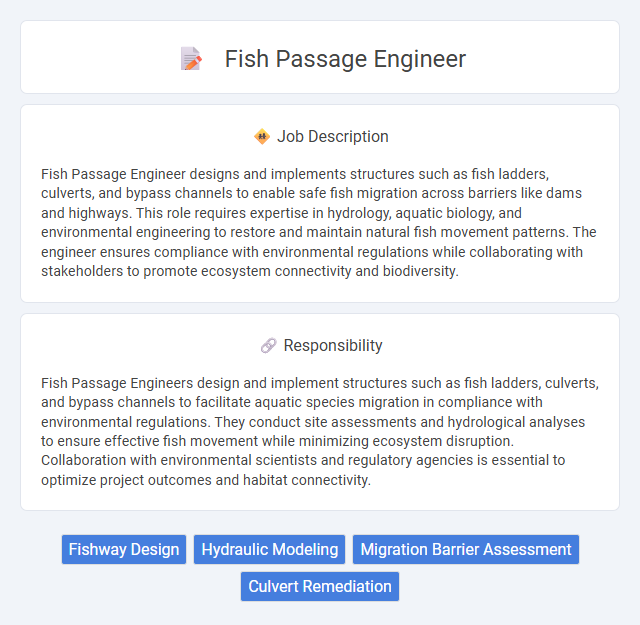
Fish Passage Engineer designs and implements structures such as fish ladders, culverts, and bypass channels to enable safe fish migration across barriers like dams and highways. This role requires expertise in hydrology, aquatic biology, and environmental engineering to restore and maintain natural fish movement patterns. The engineer ensures compliance with environmental regulations while collaborating with stakeholders to promote ecosystem connectivity and biodiversity.
Individuals with a strong background in environmental science, civil engineering, or biology are likely to be well-suited for a Fish Passage Engineer role, given the technical and ecological knowledge required. Those who enjoy fieldwork, problem-solving, and interdisciplinary collaboration might find this position fitting their skills and interests. People lacking a solid foundation in hydrology or ecological principles may face challenges adapting to the specific demands of this job.
Qualification
A Fish Passage Engineer typically requires a degree in environmental engineering, civil engineering, or a related field, with specialized knowledge in aquatic ecology and hydraulic design. Proficiency in CAD software, hydrodynamic modeling, and familiarity with regulatory frameworks for fish habitat conservation are essential qualifications. Hands-on experience in designing fish ladders, culverts, and other passage solutions that promote fish migration and ecosystem connectivity is highly valued.
Responsibility
Fish Passage Engineers design and implement structures such as fish ladders, culverts, and bypass channels to facilitate aquatic species migration in compliance with environmental regulations. They conduct site assessments and hydrological analyses to ensure effective fish movement while minimizing ecosystem disruption. Collaboration with environmental scientists and regulatory agencies is essential to optimize project outcomes and habitat connectivity.
Benefit
A Fish Passage Engineer likely offers significant environmental benefits by designing structures that facilitate the safe movement of fish across barriers like dams and culverts, promoting biodiversity and ecosystem health. Their work probably enhances fish populations and supports sustainable fisheries, contributing to ecological balance. Employing such expertise may also improve compliance with environmental regulations, reducing legal risks for infrastructure projects.
Challenge
Fish passage engineers likely encounter challenges related to designing structures that accommodate diverse species and varying water flows. Limited data on fish behavior in altered ecosystems might complicate the accuracy of passage effectiveness predictions. Balancing ecological needs with infrastructure constraints probably requires innovative, adaptive solutions.
Career Advancement
Fish Passage Engineers specialize in designing and implementing structures that facilitate safe fish migration across water barriers, playing a critical role in aquatic ecosystem conservation. Career advancement in this field typically involves progressing from entry-level engineering roles to senior positions such as senior fish passage engineer or project manager, where leadership in environmental assessment and regulatory compliance is emphasized. Expertise in hydrology, biology, and civil engineering, combined with certifications like Professional Engineer (PE), significantly enhances opportunities for promotion and involvement in large-scale restoration projects.
Key Terms
Fishway Design
Fish passage engineers specialize in designing fishways to enable safe and efficient migration of aquatic species around barriers like dams and culverts. They apply hydrodynamic modeling, ecological principles, and environmental regulations to create structures such as fish ladders, lifts, and bypass channels. Expertise in hydraulic engineering and fish behavior ensures optimal fishway performance and habitat connectivity.
Hydraulic Modeling
Fish Passage Engineers specialize in designing and optimizing structures that enable aquatic species to navigate barriers such as dams and culverts, using advanced hydraulic modeling techniques. Hydraulic modeling integrates flow dynamics, water velocity, and turbulence data to simulate fish movement and behavior, ensuring effective passage conditions. Proficiency in software like HEC-RAS, FLOW-3D, and computational fluid dynamics (CFD) is essential to create models that improve fish habitat connectivity and support sustainable ecosystem management.
Migration Barrier Assessment
Fish Passage Engineers specialize in Migration Barrier Assessment by analyzing natural and man-made obstacles such as dams, culverts, and weirs that impede aquatic species movement. They employ hydrological modeling, biological surveys, and structural evaluations to design effective fish passage solutions that restore connectivity in freshwater ecosystems. Their work supports ecological sustainability by enhancing fish migration routes essential for species reproduction and population recovery.
Culvert Remediation
Fish Passage Engineers specialize in designing and implementing culvert remediation projects to restore natural aquatic connectivity and improve fish habitats. They assess existing culvert structures for barriers to fish movement and develop solutions such as culvert removal, replacement with fish-friendly designs, or retrofitting with baffles and riffles. Expertise in hydraulic modeling, environmental regulations, and ecological impact assessment is critical for successful culvert remediation that supports ecosystem restoration and complies with conservation standards.
 kuljobs.com
kuljobs.com